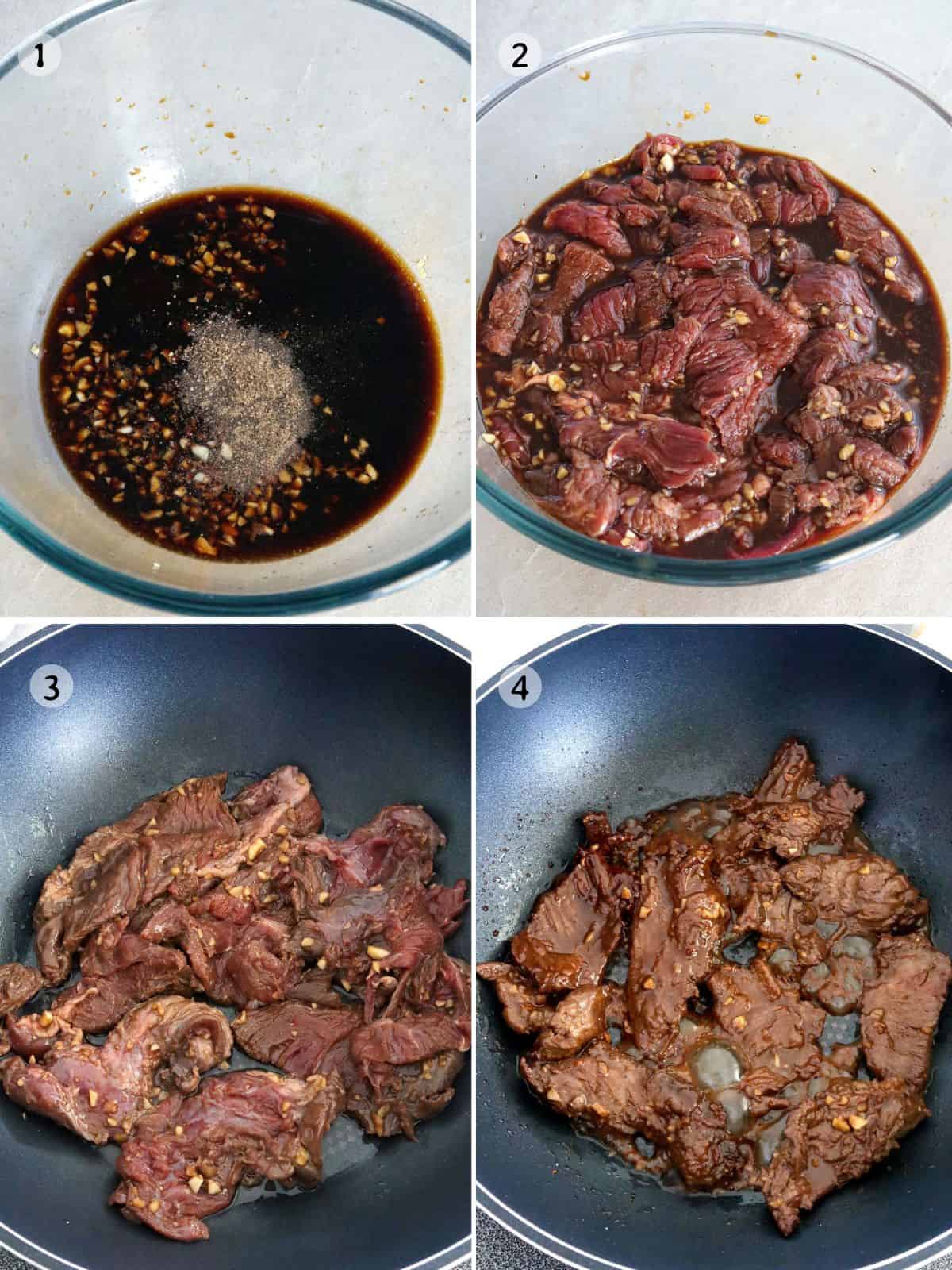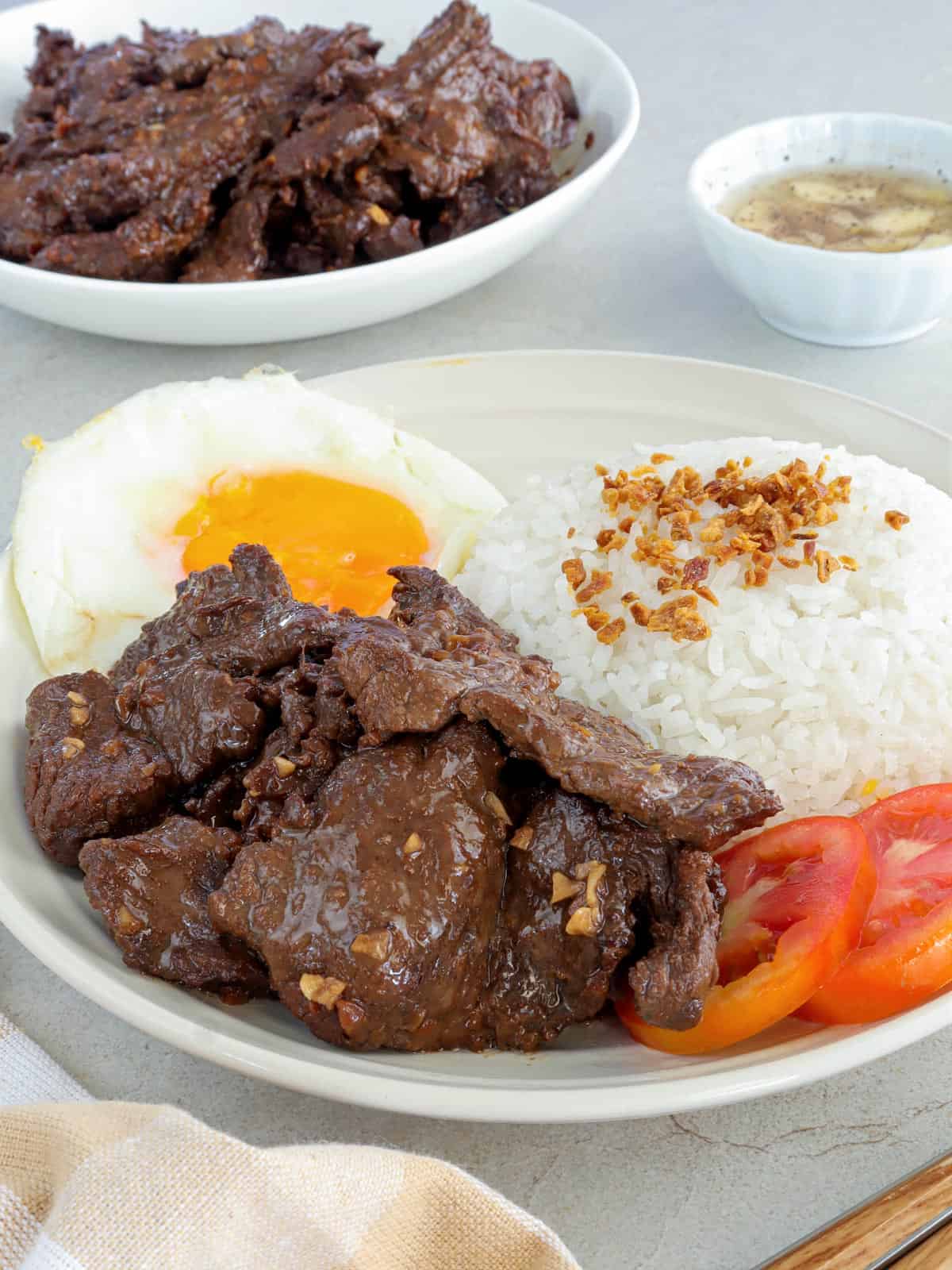[ad_1]
Filipino Beef Tapa It’s easy to make and tastes much better than store bought. Serve with garlic fried rice and sunny side up eggs for a classic Tapsilog breakfast!

The sirloin I bought and thinly sliced by the butcher at Seafood City a few days ago was so huge, at about five pounds, it was more than enough for one meal. I used about two pounds of beef and baby corn we had for lunch yesterday and turned the leftover meat into beef tapa for breakfast this weekend.
I have another beef tapa recipe on the blog with another range of flavours. While the procedure is similar, I used a marinade of fish sauce, brown sugar, and minced garlic. It’s different but delicious, the same. You can also try chicken tapa if you abstain from red meat.
What is Filipino tapa?
Tapa is a Filipino dish consisting of thin slices of beef, chicken, pork, carabao, or game meat such as deer and wild boar. The meat is traditionally cured with salt and spices and dried or smoked as a preservation method. In recent years, the process has been simplified by simply marinating the meat to impart flavor and abandoning the drying process.
After preparation, the marinated meat is fried or grilled until tender and caramelized. It is traditionally eaten as part of classic Filipino cuisine Upside down.
Note the ingredients


- meat-The recipe uses sirloin steak, which is very tender and only requires a few minutes of searing to cook. If substituting tougher cuts, such as the bottom cut, add about 1 cup of water and simmer the tapa until done before finishing with the oil until it is crispy and browned.
- Calamansi juice– Adds a tangy taste and tenderizes meat by weakening surface proteins. You can also use citrus fruits such as lemons and limes or other acidifying agents such as pickle juice, vinegar, or wine.
- I am willow– It acts as a salting agent and enhances delicious flavours
- Minced fresh garlic-For another layer of flavour; Fresh is best, but garlic powder will do the trick
- sugar– Sweetens the marinade and balances the acidic component. It helps caramelize the meat
- salt– Seasons the meat and acts as a salting agent
- Pepper– Adds a kick of heat
How to Make Filipino Beef Tapa


- Combine soy sauce, calamansi juice, garlic, sugar, salt and pepper in a non-reactive bowl. Stir until the sugar and salt dissolve.
- Add beef and massage until completely coated with marinade. Refrigerate overnight to cure. Drain the meat from the marinade.
- Heat the oil in a wide frying pan. Add the beef in a single layer and cook until the liquid expelled from the meat is almost absorbed.
- Add more oil and cook until the meat is slightly browned and caramelized. We take it out of the pan and cut it into serving portions. Serve hot.
Frequently asked questions
What does tapa taste like?
Filipino tapa has a delicious mix of sweet, salty, tangy and spicy flavours, depending on the marinade used.
What is tapa called in English?
A tapa is a snack or appetizer that is usually enjoyed with alcoholic beverages. In the Philippines, tapa is a popular dish made from thin slices of meat cured with spices or sun-dried as a form of preservation.
Cooking tips
- Cut the beef into thin slices for faster cooking and across the grain to ensure a tender chew. To make cutting easier, freeze the meat for a few minutes until it becomes slightly firm.
- Don’t marinate the meat for too long, as the acids of the marinade will denature the protein fibers and produce a mushy texture.
What is tabsilog


A portmanteau of the words tapa (bacon), sinangag (garlic fried rice), and etlog (fried egg), tapsilog is a popular Filipino meal served as an all-day breakfast. This delicious tapa, rice and egg combination is usually enjoyed alongside a spicy vinaigrette, fresh tomato salad or atchara.
Storage instructions
Transfer the beef to a container with a tight-fitting lid and refrigerate for up to 3 days or freeze for up to 2 months. Reheat in a dry frying pan, turning on the sides as needed, until heated through, or in an air fryer at 350°F for 3 to 5 minutes, depending on thickness.
Marinated beef can be stored uncooked. Transfer to an airtight container, refrigerate, and use within three days. For longer storage, freeze for up to 6 months. Defrost completely in the refrigerator when ready to cook.
Did you make this? Be sure to leave a comment below and tag me @kawalingpinoy on Facebook and Instagram!


Beef tapa is a classic Filipino dish often served for breakfast with garlic fried rice and sunny side up eggs. It’s easy to make and is sure to be a family favorite.
turn: breakfast
Shares
ingredients
- ½ cup I am Willow
- ¼ cup Calamansi juice
- 1 head Peeled and chopped garlic
- 2 tablespoons sugar
- ½ small spoon salt
- ¼ small spoon Pepper
- 3 Pound or pound Beef steak, cut into thin slices
- canola oil
directions
-
In a non-reactive bowl, combine soy sauce, calamansi juice, garlic, sugar, salt, and pepper. Stir until the sugar and salt dissolve.
-
Add beef and massage until completely coated with marinade. Keep overnight in the refrigerator to cure. Drain the meat from the marinade.
-
In a wide frying pan over medium heat, heat about 1 tablespoon of oil.
-
Add beef in a single layer and cook on both sides for 3 to 5 minutes or until liquid is almost absorbed (meat will dissipate liquid).
-
Add another tablespoon of oil and continue cooking until the meat is lightly browned and caramelized.
-
We take it out of the pan and cut it into serving portions. Serve hot.
Notes
- Cut the beef into thin slices for faster cooking and across the grain to ensure a tender chew. To make cutting easier, freeze the meat for a few minutes until it becomes slightly firm.
- Don’t marinate the meat for too long, as the acids of the marinade will denature the protein fibers and produce a mushy texture.
- If substituting tougher cuts, such as the bottom cut, add about 1 cup of water and simmer the tapa until done before finishing with the oil until it is crispy and browned.
video


Nutrition information
Calories: 354Calories, Carbohydrates: 7g, protein: 51g, fat: 12g, Saturated fat: 3g, Cholesterol: 125mg, sodium: 1406mg, Potassium: 834mg, Fiber: 1g, sugar: 5g, Vitamin C: 5mg, Calcium: 58mg, iron: 5mg
“This site provides approximate nutrition information for convenience and as a courtesy only. Nutrition data is collected primarily from the USDA Food Composition Database, whenever available, or from other online calculators.
[ad_2]

